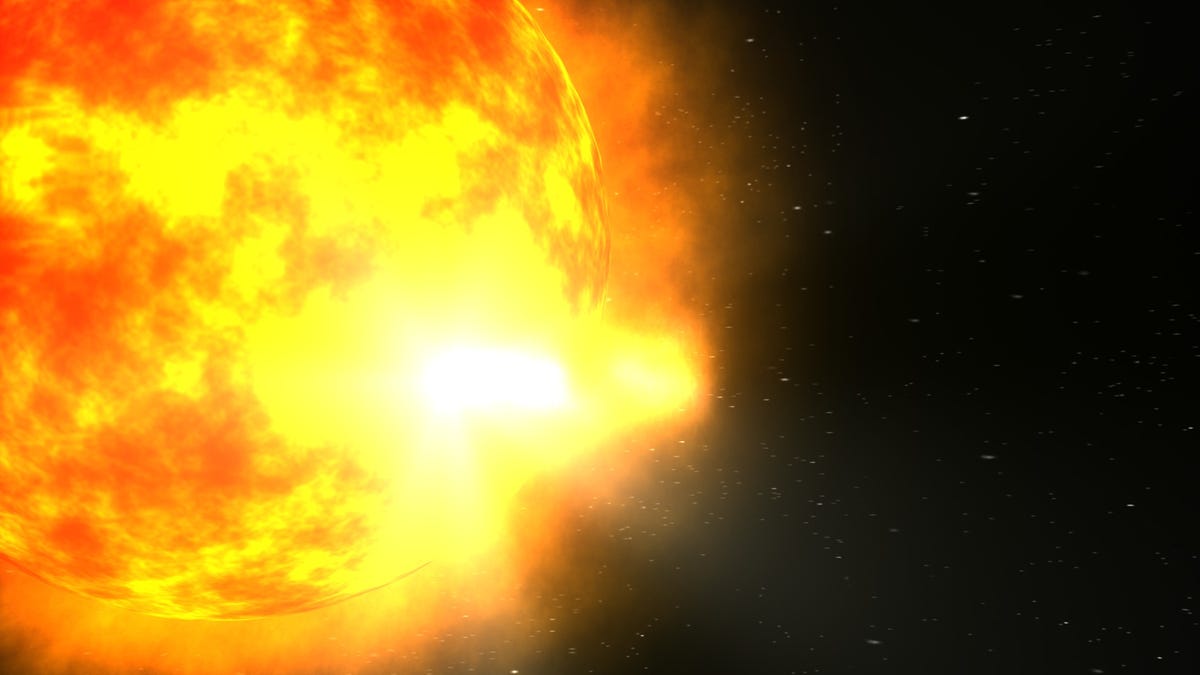Look for a Dazzling Aurora Thanks to a 'Cannibal' Blast From the Sun
A sunspot unleashed a barrage of 17 solar flares on Monday and multiple waves of charged particles that can create so-called "Northern Lights" when they smack into our magnetic field.

An illustration of a powerful solar flare.
Our local star has been literally erupting this week in a frenzy of flares that have affected some radio communications and may put on quite a display for skywatchers.
Sunspot AR2975 went hyperactive on Monday, unleashing 11 small C-class flares and six medium M-class flares. Flares travel from the sun to Earth at the speed of light, arriving in mere minutes to disrupt shortwave radio and some other forms of communication. Mariners and pilots, particularly in the south Atlantic and polar regions, reported disruptions on Monday.
For the rest of us, it's the coronal mass ejections (CMEs) that often accompany flares worth looking out for. These blasts of charged particles take a few days to arrive at Earth (if the burst is aimed in our direction) and when they smash into the magnetosphere they can produce dancing Aurora Borealis in the Northern Hemisphere and Aurora Australis in the south.
The view of a hyperactive sun via NASA's Solar and Heliospheric Observatory.
The sun's outburst sent at least two CMEs in our direction, but the more recent blast is traveling faster than the first and is expected to overtake the earlier CME, a phenomenon called a "cannibal CME."
"Cannibal CMEs are fast coronal mass ejections that sweep up slower CMEs in front of them," explains astronomer Tony Phillips for spaceweatherarchive.com. "The mishmash contains tangled magnetic fields and compressed plasmas that can spark strong geomagnetic storms."
NOAA's Space Weather Prediction Center has indeed issued a watch for a G3, or strong geomagnetic storm, in effect for Thursday. Such storms can threaten damage to satellites and even our surface electrical grid in extreme cases. A February geomagnetic storm is thought to have essentially destroyed more than three dozen SpaceX Starlink satellites.
However, NOAA isn't expecting much fallout from this cannibalistic burst of energy.
"Impacts to technology from a G3 storm generally remain small, but it can drive the aurora further equatorward of its polar home," the watch reads.
The strong storm could make aurora visible in the Northern Hemisphere as far south as 50 degrees of geomagnetic latitude, which includes parts of Oregon and Illinois in the US.
Aurora seen above Glacier National Park in Montana on Wednesday.
Phillips says to keep an eye out for dancing colors after night falls Wednesday in North America. In Europe, it's better to venture out in the early morning hours Thursday.
"When chasing auroras, dark skies are essential; go to the countryside," Phillips says. "Urban glare can overwhelm auroras even during a strong geomagnetc storm."
If the weather doesn't cooperate or you aren't able to see any aurora where you are, there may be plenty more opportunities. The sun is expected to see a continued increase in sunspot and flare activity over the next couple of years, building to a peak in the current solar cycle around 2025.

